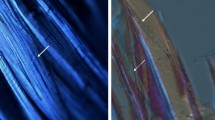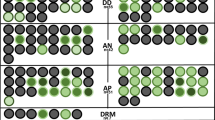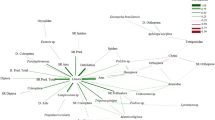Abstract
The marine isopod Limnoria tripunctata is unique among wood borers in its ability to inhabit and severely damage creosote-treated wooden structures, yet little is known of the nature of this apparent resistance to creosote. When the animal is reared on untreated wood, its digestive tract appears to be free of microorganisms2–6. In contrast, we report here that microorganisms are readily observed in the digestive tract of L. tripunctata inhabiting creosote-preserved wooden pilings. Furthermore, isopods from such preserved wood apparently possess a resident gut microflora, which is in close association with the lining of the intestinal tract and is separated by a peritrophic membrane from other microorganisms ingested during wood boring.
This is a preview of subscription content, access via your institution
Access options
Subscribe to this journal
Receive 51 print issues and online access
$199.00 per year
only $3.90 per issue
Buy this article
- Purchase on Springer Link
- Instant access to full article PDF
Prices may be subject to local taxes which are calculated during checkout
Similar content being viewed by others
References
Hochman, H., Vind, H., Roe, Jr., T., Muraoka, J. & Casey, J. Tech. Mem. M-109 US Navy Civ. Engng Res. Eval. Lab. 1–43 (1956).
Kalnins, M. A. Proc. Am. Wood Preserv. Ass. 52, 113 (1976).
Sleeter, T. D., Boyle, P. J., Cundell, A. M. & Mitchell, R. Mar. Biol. 45, 329–336 (1978).
Boyle, P. J. & Mitchell, R. Science 200, 1157–1159 (1978).
Larkin, F. T. Rep. Mar. Borer Conf. US Navy Civ. Engng Res. Eval. Lab. L1–L3 (1951).
Ray, D. L. Proc. Am. Wood Preserv. Ass. 55, 147–154 (1959).
Oliver, A. C. J. Inst. Wood Sci. 9, 32–91 (1962).
Ray, D. L. & Julian, J. R. Nature 169, 32–33 (1952).
Ray, D. L. in Marine Boring and Fouling Organisms (ed. Ray, D. L.) 46–61 (University of Washington Press, Seattle, 1959).
Drisko, R. W. & Hockman, H. Biol Bull. 112, 325–329 (1957).
Lane, C. E. in Marine Boring and Fouling Organisms (ed. Ray, D. L.) 34–35 (University of Washington Press, Seattle, 1959).
Meyers, S. P. & Reynolds, E. S. Science 129, 969 (1957).
Schafer, R. D. & Lane, C. E. Bull. mar. Sci. Gulf Carib. 7, 289–296 (1957).
Kohlmeyer, J., Becker, F. & Kampf, W. D. Z. angew. Zool. 46, 457–489 (1959).
Mercer, E. H. & Day, M. F. Biol. Bull. 103, 384–394 (1952).
Zimmerman, U., Mehlan, E. & Peters, W. Comp. Biochem. Physiol. 51 B, 181–186 (1975).
Brandt, C. R., Adang, M. J. & Spence, K. D. J. Invert. Pathol. 32, 12–14 (1978).
Lautenschlager, K. P., Kaushik, N. K. & Robinson, J. B. Freshwater Biol. 8, 207–211 (1978).
Shively, J. M. A. Rev. Microbiol. 28, 167–187 (1974).
Scott, C. C. L. & Finnerty, W. R. J. gen. Microbiol. 94, 342–350 (1976).
Author information
Authors and Affiliations
Rights and permissions
About this article
Cite this article
Zachary, A., Colwell, R. Gut-associated microflora of Limnoria tripunctata in marine creosote-treated wood pilings. Nature 282, 716–717 (1979). https://doi.org/10.1038/282716a0
Received:
Accepted:
Issue Date:
DOI: https://doi.org/10.1038/282716a0
This article is cited by
-
Bioprospecting metagenomics of decaying wood: mining for new glycoside hydrolases
Biotechnology for Biofuels (2011)
-
The enumeration and characterization of bacteria and fungi associated with marine wood-boring isopods, and the ability of these microorganisms to digest cellulose and wood
Marine Biology (1994)
-
Widespread occurrence of extensive epimural rod bacteria in the hindguts of marine Thalassinidae and Brachyura (Crustacea: Decapoda)
Marine Biology (1993)
-
Possible role of marine bacteria in providing the creosote-resistance of Limnoria tripunctata
Marine Biology (1983)
-
Intestinal microflora in the deep-sea isopodBathynomus giganteus
Current Microbiology (1982)
Comments
By submitting a comment you agree to abide by our Terms and Community Guidelines. If you find something abusive or that does not comply with our terms or guidelines please flag it as inappropriate.



